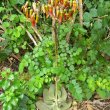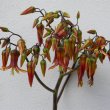| Botanical Name |
|
| Family |
Crassulaceae - The crassula family. |
| Pronunciation |
kot-ee-LEE-don veh-lew-TIH-nah |
| Common Name(s) |
Afrikaans: Plakkie; Varkoor
|
| Plant Group |
- Succulent A plant having fleshy stems or leaves often adapted to dry conditions.
|
| Plant Size |
- Very large
| Tree | Over 25m |
| Shrub | Over 4m |
| Perennial/ground cover | Over 1m |
| Bulb | Over 1.2m |
| Succulent | 1.5m to 2m |
- Medium
| Tree | 10m to 16m |
| Shrub | 1m to 2m |
| Perennial/ground cover | 40cm to 60cm |
| Bulb | 40cm to 60cm |
| Succulent | 40cm to 60cm |
|
| Position |
- Dry Shade Shady areas where soil has poor water retention or are dependent on rain for their moisture needs.
- Light or Dappled Shade Found below trees with sparse, open foliage. Ideal for the protection of herbaceous plants.
- Partial Shade The area is in shade for part of the day and in full sun for part of the day.
- Sun The area is in full sun for all or most of the day, all year round.
|
| General Information |
- Drought Tolerance: High The plant is well adapted to arid conditions; it can survive long periods of drought and high temperatures without extra water.
- Evergreen Plants that have leaves all year round.
- Frost: Half-hardy The plant is able to survive low temperatures and some frost but requires protection against severe frost.
- Sand tolerant Plants adapted to survive in nutrient poor, very sandy soils.
- Water Wise Plant species originating from low rainfall regions that require less water to survive and thrive than other plant species.
|
| Specific Information |
Cotyledon velutina is the biggest of the Cotyledons, growing to a large, succulent like shrub (although I have never seen it more than about knee-high). I found little data about this plant. More information will be appreciated.
|
| Ad Break |
|
| Flowers |
| Description |
tubular on branched stems with blooms hanging down in loose heads
|
| Season |
- Spring to Summer Plants will seldom bloom for the entire season as given in the list, but should flower during a period within these parameters.
|
| Colour |
|
| Growth Rate |
- Moderate to Fast Specifying growth rate can be very misleading as there is considerable variation of growth rate depending on type and species of plant, available water, supplementary feeding, mulching and general care, as well as the plants suitability and adaptability to the garden environment.
|
| Plant Uses |
- Attracts bees, butterflies or other insects This plant attracts insects which can be food for birds or other creatures in your garden.
- Attracts Birds This plant will attract birds.
- Border A strip of ground, at the edge of a driveway or path in which ornamental plants or shrubs are planted.
- Boundary A plant useful for planting around the edges of the property to form a green or colourful backdrop, an impenetrable hedge, to hide walls or create privacy.
- Container Trees, shrubs and ornamental species that can adapt to growing in a restricted environment.
- Filler Either a fast growing tree or shrub used temporarily to fill in an area while the permanent plants grow to a desired size, or a plant used to fill gaps in borders or beds.
- Suitable for coastal gardens Plants adapted to dry, sandy soil, forceful wind, limited rainfall and intense sunlight.
- Wild Garden An indigenous garden planted for the benefit of wildlife and birds. Provides food, water, a variety of mini-biomes and no poisonous chemicals are used.
|
| Distribution and Habitat |
drier parts of the Eastern Cape
|
| Planting Suggestions |
Plant in full sun or a little light shade, in well-drained soil to which a little compost can be added. Mulch lightly, water weekly until established. Water only when very dry - this plant is water wise and should survive without much further attention.
|
| Medicinal Uses |
|
| Ad Break |
|








Comments
plant ID Cotyledon??
http://eefalsebay.blogspot.com/2014/06/baviaanskloof-and-on-to-willowmor...
Do you think this is velutina?
Cotyledon velutina
Hi Diana
It would appear to be. The flower, growth form and leaf shape are right and although not pronounced, there does appear to be a thin line of red around the leaves. The only problem is that Cotyledon velutina is endemic to the Eastern Cape: garden escapee perhaps?
As I am only a gardener and not a botanist, I cannot say a definite yes or no, but I can say that it is most likely.
I am really impressed with your website. I will certainly be a regular visitor.
Kind regards
Lorraine
plant ID Cotyledon??
the picture was taken in Baviaanskloof in the Eastern Cape
Cotyledon velutina
Hi Diana
In that case, I would say Cotyledon velutina is a definite.
Regards
Lorraine
Discuss this plant
Share knowledge, ask a question or give an experience.